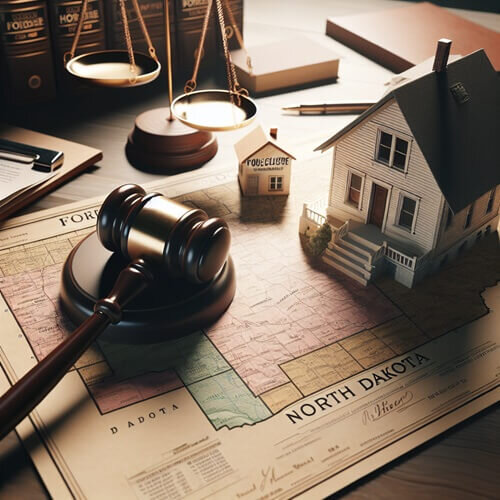The North Dakota foreclosure process timeline is essential for homeowners facing financial difficulties. In North Dakota, the foreclosure process typically begins when the borrower fails to make mortgage payments as agreed upon in the loan agreement. The lender must first send a written notice to the borrower, known as a Notice of Default, informing them of the delinquency and providing a period to cure the default.
If the borrower fails to rectify the situation within the given timeframe, the lender may proceed with filing a foreclosure lawsuit. This legal action initiates the judicial foreclosure process, which involves the court overseeing the proceedings. Throughout this process, various stages and hearings take place. For instance, the summons service allows the borrower to present a defense against the foreclosure. Ultimately, if the borrower cannot resolve the default, the foreclosure sale occurs. Homeowners in North Dakota need to familiarize themselves with the specific steps and timelines involved in the foreclosure process to navigate it effectively and potentially explore alternatives to foreclosure. If you want to sell your home quickly in North Dakota, we buy houses in North Dakota and can help you through the challenging foreclosure process.
Understanding North Dakota’s Foreclosure Laws
Understanding North Dakota’s foreclosure laws is crucial for homeowners and potential buyers. North Dakota follows a judicial foreclosure process, meaning the foreclosure must go through the court system. This process typically begins when the lender files a lawsuit against the homeowner, known as the borrower. The borrower is then served with a summons and complaint, initiating the legal proceedings. It is important to note that North Dakota is a recourse state, meaning that lenders have the right to seek a deficiency judgment if the foreclosure sale does not fully satisfy the outstanding mortgage debt.
Understanding the intricacies of North Dakota’s foreclosure laws can help individuals navigate the process effectively and make informed decisions.
The Role of North Dakota’s Foreclosure Laws

North Dakota’s foreclosure laws are crucial to the state’s foreclosure process timeline. These laws are designed to protect homeowners and the lenders involved in foreclosure proceedings. One important aspect of North Dakota’s foreclosure laws is the requirement for a judicial foreclosure process. This means that before a foreclosure occurs, the lender must file a lawsuit against the homeowner and obtain a court order. This ensures the homeowner can defend themselves and present valid defenses or mitigating circumstances.
Another significant role of North Dakota’s foreclosure laws is the provision for a redemption period. This period allows the homeowner to reclaim their property by paying off the outstanding debt within a specified timeframe. North Dakota’s foreclosure laws also outline the procedures for public notice and auction of the foreclosed property, ensuring a transparent and fair process. By providing these legal safeguards, North Dakota’s foreclosure laws aim to balance protecting homeowners’ rights and facilitating the efficient resolution of foreclosure cases.
Key Factors Influencing Foreclosure Laws in North Dakota
Key Factors Influencing Foreclosure Laws in North DakotaUnderstanding the key factors that influence foreclosure laws in North Dakota is crucial for homeowners and lenders alike. Several significant factors shape these laws, ensuring a fair and balanced process for all parties involved.
- Firstly, North Dakota’s foreclosure laws are influenced by the state’s judicial system, which requires all foreclosures to go through the courts. This ensures the process is conducted with proper legal oversight and allows homeowners to defend their rights. The state’s economy plays a vital role in shaping these laws.
- Economic fluctuations and unemployment rates can impact foreclosure rates, prompting policymakers to adapt legislation accordingly.
- Protection of homeowners’ rights. North Dakota’s foreclosure laws prioritize the preservation of homeownership and aim to provide homeowners with alternatives to foreclosure, such as loan modifications or repayment plans.
- Federal regulations and guidelines also influence foreclosure laws in North Dakota. These regulations, including the Dodd-Frank Act and the Consumer Financial Protection Bureau’s rules, provide a framework for fair and ethical foreclosure practices.
- Public sentiment and social factors, such as community stability and the impact of foreclosures on neighborhoods, can also shape foreclosure laws.
Overall, a combination of legal, economic, homeowner-centric, federal, and societal factors influences the foreclosure laws in North Dakota, ensuring a comprehensive and balanced approach to the foreclosure process.
Other Articles You Might Enjoy
- New York Foreclosure Process Timeline
- North Carolina Foreclosure Process Timeline
- New Jersey Foreclosure Process Timeline
- New Mexico Foreclosure Process Timeline
- Nevada Foreclosure Process Timeline
Initiation of the Foreclosure Process in North Dakota
Initiation of the foreclosure process in North Dakota follows a well-defined timeline. The process begins when the homeowner fails to make timely mortgage payments, prompting the lender to issue a Notice of Default. This document notifies the homeowner of their delinquency and provides a specified period for them to rectify the situation.
If the homeowner fails to respond or remedy the default, the lender proceeds with filing a foreclosure lawsuit in the appropriate county court. Once the lawsuit is initiated, the homeowner receives a Summons and Complaint, formalizing the legal proceedings. The homeowner must respond within the specified timeframe to present defenses or negotiate a resolution. Failure to respond can result in a default judgment, leading to the next phase of the foreclosure process.
The Beginning of the Foreclosure Process
The foreclosure process can be a daunting and complex journey for homeowners in North Dakota. It marks the beginning of a challenging period that requires careful attention to detail and timely action. The process typically starts when a borrower falls behind on mortgage payments, triggering events that can ultimately lead to the loss of their home. It begins with the lender sending a notice of default, informing the borrower that they have violated the terms of their mortgage agreement.
This notice serves as a wake-up call, urging the homeowner to rectify the situation immediately. From there, various legal steps are taken, such as filing a lawsuit and obtaining a court order, to initiate the formal foreclosure process. Homeowners must seek professional guidance and explore all available options to avoid foreclosure and protect their investment potentially. Understanding the intricacies of the beginning of the foreclosure process is paramount in navigating this challenging terrain.
Call Now (818) 651-8166
Why Sell Your Home to ASAP Cash Offer?
- You Pay Zero Fees
- Close quickly 7-28 days.
- Guaranteed Offer, no waiting.
- No repairs required, sell “AS IS”
- No appraisals or delays.
Legal Notices in the Initial Stages of Foreclosure
Legal Notices in the Initial Stages of Foreclosure play a vital role in the North Dakota Foreclosure Process Timeline. These notices are formal communication to inform the property owner about the impending foreclosure proceedings. In North Dakota, the foreclosure process begins with the lender filing a Notice of Default, a legal document that notifies the borrower of their default on the mortgage payments. This notice includes important information such as the outstanding amount, the deadline for payment, and the consequences of failing to comply.
The purpose of this initial notice is to allow the borrower to rectify the default and avoid further legal actions. It is crucial for the property owner to carefully review the legal notice and take appropriate action to address the default promptly. Failure to respond to these notices may result in the initiation of formal foreclosure proceedings, leading to the eventual sale of the property. Therefore, borrowers must understand the significance of these legal notices and seek professional advice to navigate through the initial stages of foreclosure effectively.
The Judicial Foreclosure Timeline in North Dakota
The judicial foreclosure timeline in North Dakota can be a complex process for homeowners facing the possibility of losing their homes. Understanding the various stages of this legal procedure is crucial for anyone navigating the North Dakota foreclosure process. The timeline typically begins when the lender files a lawsuit against the homeowner, initiating the judicial foreclosure process. Once the lawsuit is filed, the homeowner will receive a summons and complaint, which outlines the lender’s allegations and provides a timeframe for the homeowner to respond. Homeowners need to seek legal counsel at this stage to ensure they understand their rights and responsibilities. Following the response period, the court will schedule a hearing to review the case.
Both parties will present their arguments during the hearing, and the court will decide on the foreclosure. If the court rules in favor of the lender, a judgment of foreclosure will be issued, and a sale date will be set. The sale date allows interested buyers to bid on the property, and the highest bidder will become the new owner. Throughout this process, homeowners can negotiate alternatives, such as loan modifications or short sales, to avoid foreclosure. It is important to remember that each foreclosure case in North Dakota is unique and may have variations in the timeline depending on the specific circumstances. Seeking professional guidance and understanding the intricacies of the judicial foreclosure timeline is crucial for homeowners in North Dakota facing this challenging situation.
Other Articles You Might Enjoy
- New Hampshire Foreclosure Process Timeline
- Nebraska Foreclosure Process Timeline
- Montana Foreclosure Process Timeline
- Mississippi Foreclosure Process Timeline
- Kansas Foreclosure Process Timeline
Steps Involved in North Dakota’s Judicial Foreclosure
North Dakota’s judicial foreclosure process involves several steps that must be followed to ensure a fair and legal resolution.
- The first step is filing a foreclosure lawsuit by the lender in the appropriate court. This initiates the legal proceedings and notifies the borrower of the foreclosure action.
- The next step is the service of process, where the borrower is officially notified of the lawsuit and allowed to respond.
- Once the borrower has been served, they have a specific period to file an answer or other responsive pleading.
- Failure to respond within the allotted time may result in a default judgment in favor of the lender.
- If the borrower files an answer, the case proceeds to the discovery phase, where both parties gather evidence and exchange information relevant to the foreclosure.
- Following discovery, the court may schedule a pre-trial conference to discuss settlement options and potentially avoid a trial.
- If no settlement is reached, the case moves to trial, where both parties present their arguments and evidence.
- After considering the evidence, the court will decide and issue a judgment.
- If the decision favors the lender, the foreclosure sale will be scheduled.
- The property will be sold at a public auction, and the proceeds will be used to satisfy the outstanding debt.
- The lender will issue a deed to the new owner, transferring ownership of the property.
This comprehensive process ensures that all parties involved have an opportunity to present their case and that the foreclosure is carried out by North Dakota’s legal requirements.
The Timeline of a Typical Judicial Foreclosure in North Dakota
The judicial foreclosure process in North Dakota typically follows a timeline that involves several stages. Firstly, the lender initiates the foreclosure by filing a lawsuit against the borrower. This initiates the pre-foreclosure period, during which the borrower has an opportunity to respond and potentially resolve the default. If the borrower fails to respond or reach a resolution, the court proceeds with a judgment of foreclosure. Following the judgment, a sheriff’s sale is scheduled, where the property is auctioned off to the highest bidder.
The winning bidder must pay the full amount in cash and receives a sheriff’s certificate of sale. However, the borrower still has a redemption period in which they can reclaim the property by paying the total amount owed. If the redemption period passes without action from the borrower, the winning bidder can apply for a sheriff’s deed, transferring ownership. It is important to note that the timeline can vary depending on various factors, including the borrower’s response and the court’s caseload.
Alternatives to Foreclosure in North Dakota
If you find yourself facing the possibility of foreclosure in North Dakota, rest assured that there are alternatives available to help you navigate this challenging situation. One option to consider is a loan modification, which involves negotiating with your lender to modify the terms of your mortgage to make it more affordable. Another alternative is a short sale, where you sell your home for less than what you owe on the mortgage, with the lender agreeing to accept the proceeds as full payment.
You could explore the possibility of a deed in lieu of foreclosure, where you voluntarily transfer the ownership of your property to the lender in exchange for the forgiveness of your mortgage debt. Lastly, it may be worth consulting with a reputable credit counseling agency to discuss potential options for debt management or refinancing. Remember, each case is unique, and it is important to seek professional advice to determine which alternative is best suited to your specific circumstances.
Loan Modification as an Alternative to Foreclosure
Loan Modification can be a viable alternative to foreclosure for homeowners in North Dakota facing financial difficulties. This process involves negotiating with the lender to modify the terms of the existing mortgage, making it more affordable and sustainable for the borrower. By adjusting the interest rate, extending the loan term, or even reducing the principal balance, homeowners can potentially lower their monthly mortgage payments and avoid the devastating consequences of foreclosure.
Loan modification provides a glimmer of hope for individuals who are struggling to meet their financial obligations and want to keep their homes. It offers the opportunity to regain control over their finances and maintain homeownership, providing a lifeline amidst the challenging North Dakota foreclosure process timeline.
Short Sale and Deed in Lieu as Foreclosure Alternatives in North Dakota
When facing the possibility of foreclosure in North Dakota, homeowners may find solace in considering alternative options such as Short Sale and Deed in Lieu. Short Sale refers to the process of selling a property for less than the outstanding mortgage balance, with the lender’s approval. This can be a viable option for homeowners who are unable to keep up with mortgage payments and wish to avoid the consequences of foreclosure.
On the other hand, Deed in Lieu involves voluntarily transferring the property’s ownership to the lender in exchange for the cancellation of the mortgage debt. This option can be suitable for homeowners who are unable to sell their property through a Short Sale or prefer a more expeditious resolution. Both Short Sale and Deed in Lieu provide alternatives to foreclosure, allowing homeowners in North Dakota to potentially mitigate the financial and emotional burdens associated with the foreclosure process.


